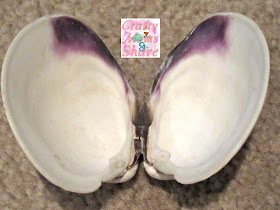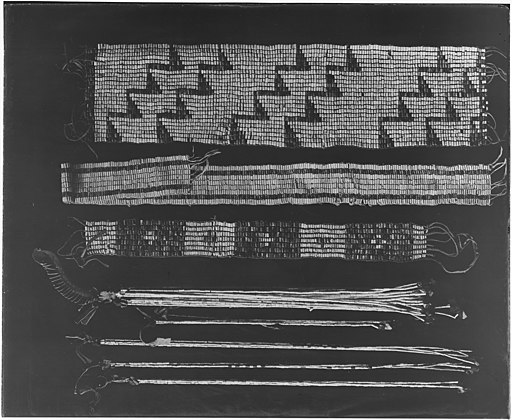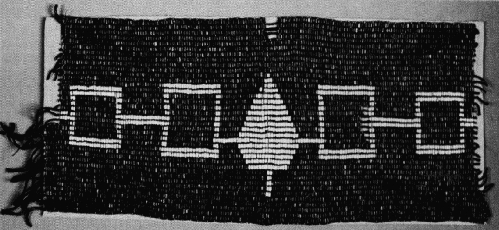November is Native American Heritage Month. This year I thought I would explore wampum and how it is made. Wampum jewelry is very popular on Cape Cod and this summer I was told how hard (and dangerous) it is to make. This is why it costs so much.
 |
| Wampam Beads Made by Elizabeth James Perry (Wampanoag/Eastern Cherokee) By Uyvsdi [Public domain], via Wikimedia Commons |
What Is Wampum?
Wampum are beads made from shells. They are usually made from quahog shells and some of the white ones are made from whelk shells. The Native Americans have used these beads in ceremonies, for communication and as currency.
 |
| Quahog Clam Shell |
Making Wampum Beads
Now being at Cape Cod so much, we are lucky to find quahog shells often. You can see why there is a variance in the colors of wampum.Quahog shells are used to make the purple wampum. The darker the purple the more valuable. You can see on these unrefined shells there is not much purple in them. Plus to make the beads the thickest part of the shell needs to be used. Most shells only have a narrow strip that can be used to make a wampum bead.
Once the clam shell is cleaned and dried the beadmaker breaks the shell into pieces with a hammer or pliers. It is important not to breathe in the toxic dust from the shell. Then the piece is given a shape and a hole is drilled into it. The edges are sanded with sandpaper. There are more complicated beads to make with more complex tools these days. Nowadays the beadmakers use jewelry saws, grinders, and buffers. The beads are not coated with anything. The shine comes from the buffing and their own beauty.
 |
| Necklace Hazel purchased at powwow |
History of Wampum
Records show that wampum was used in jewelry long before the formation of the Iroquois Confederacy and shell beads have been found in the Northeast that date to 4500 years ago. The beads from long ago were less common because of the difficulty to drill them with stone drill bits, but were used in ceremonial contexts with a connection to the life giving water. The shapes were flatter because of the lack of tools to make them into other shapes.
In the Haudenosaunee tradition, wampum is sacred. Its origins go back to the story of Hiawatha, one of the co-founders of the Iroquois Confederacy. It is believed that when Hiawatha was grieving the loss of his family and his failure to unite his people he walked when he found fresh water clam shells in a dry lake bed and strung them together. He used these strands to bring a message of healing to his people. Legend also says he used strands of wampum to persuade Tadodaho who was a feared leader before the forming of the Iroquois Confederacy.
Over time the shape of the wampum beads has changed. Before European contact they tended to disc or barrel shape. With European contact they were given metal drills and able to drill holes more easily. This changed the shape and size of the beads. Wampum was produced on the Southern coast of New England. The Naragansetts, Pequot, and Wampanoag monopolized the production of it in this area.
 |
| Wampum Necklace By Pierre5018 [CC BY-SA 4.0 ], from Wikimedia Commons |
In Native American cultures possession of wampum beads gave the person authority to speak for the people and provide a way to record agreements among nations. This is true still today. Clan mothers and chiefs have their own strings of wampum that symbolize their positions of honor and responsibility in the community.
 |
| Wampum Belts National Archives at College Park [Public domain], via Wikimedia Commons |
Wampum is often strung to make beautiful patterns. Each pattern represents a person, nation, agreement, a particular event or invitation. The symbols help people remember history and tell complex ideas without words. The white beads stand for peace, friendship and harmony and the purple beads represent war, suffering and events of great importance.
When the Europeans came to New England and began to form the colonies they saw how the Native Americans valued their shell beads over gold and silver. There was also a lack of metal coins in the colonies so the wampum soon became a type of currency. Eventually the metal coins made their way to America and the use of wampum as a currency in the colonies was discontinued.
Many of the special wampum was stolen or improperly sold. They are all owned by the Iroquois Condfedercy. In 1989 the United States passed a law that wampum artifacts must be returned to their rightful owners. Many have been returned so they can be used to teach and in ceremonies.
Hiawatha's Belt
Probably the most famous artifact is Hiawatha's Belt. It is a symbol of the agreement between the five original nations of Haudenosaunee Nation. It represents their promise to live in harmony and help one another in times of struggle. The four squares represent the Mohawk, Oneida, Cayuga, and Seneca Nations. The Onondaga Nation is the keeper of the council fire and is represented by the tree in the center. The lines extended out from the outer squares represent the path for others to live in peace with them or join the confederacy. This is a wonderful example of the history and communication in the beadwork. |
| Hiawatha's Belt Junuxx at Dutch Wikipedia [GFDL, CC-BY-SA-3.0 or CC BY-SA 2.5 ], via Wikimedia Commons |
Sources:
- Bogas, Paula. eHow. "How to Make Wampum Jewelry." https://www.ehow.com/how_12210790_make-wampum-jewelry.html
- Carolyn. Wandering Bull. "Wampum Beads History." 29 March 2016. https://wanderingbull.com/wampum-beads-history/
- Currier, Geoff. Martha's Vineyard Magazine. "Making Wampum Jewelry." 1 July 2008. http://mvmagazine.com/news/2008/07/01/making-wampum-jewelery
- Gates, C.H. Quahog.com. "Jewelry Grade Quahog Shells Have Been Rare Since the Days of Roger Williams. Here's Why." http://www.quahog.com/shells.html
- Learning Longhouse. "Wampum." http://i36466.wixsite.com/learninglonghouse/wampum
- Native Tech. "Wampum History and Background." http://www.nativetech.org/wampum/wamphist.htm
- Perry, Elizabeth James. "About the Art of Wampum." https://www.elizabethjamesperry.com/about-wampum-art.php
- Wikipedia. "Hiawatha." https://en.wikipedia.org/wiki/Hiawatha
- Wikipedia. "Tadodaho." https://en.wikipedia.org/wiki/Tadodaho
Welcome to our fifth annual celebration of Native American Heritage Month! Today our bloggers are sharing posts about teaching children about these rich cultures. See the list of participating blogs below, and don't forget to link up your own posts as well! Don't miss our series from last year, 2016, 2015, and 2014, plus you can find even more ideas on our Native/Indigenous Cultures Pinterest board: Follow Multicultural Kid Blogs's board Native/Indigenous Cultures on Pinterest.





No comments:
Post a Comment
I love to hear your comments and ideas. Thank you for reading and contributing!